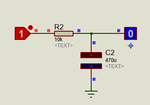ard
Full Member level 5
- Joined
- May 3, 2009
- Messages
- 251
- Helped
- 52
- Reputation
- 104
- Reaction score
- 50
- Trophy points
- 1,308
- Location
- Mumbai, India
- Activity points
- 2,783
Hello all,
I have a microcontroller driving a relay from one of its io pins.
My code, hardware works fine, except for one small, but critical issue.
When I switch on the circuit, all pins of the controller (regardless whether they're set up as inputs or outputs), flash high for a few milliseconds before the code takes over and they settle low.
While this might not be an issue in most applications, in my case this is unacceptable, as the pin drives a solenoid to open a door.
How can I suppress this? A 555 delay trigerred by the output, and then driving the solenoid? I'm hoping somebody could suggest a simpler transistorised solution.
Regards.
I have a microcontroller driving a relay from one of its io pins.
My code, hardware works fine, except for one small, but critical issue.
When I switch on the circuit, all pins of the controller (regardless whether they're set up as inputs or outputs), flash high for a few milliseconds before the code takes over and they settle low.
While this might not be an issue in most applications, in my case this is unacceptable, as the pin drives a solenoid to open a door.
How can I suppress this? A 555 delay trigerred by the output, and then driving the solenoid? I'm hoping somebody could suggest a simpler transistorised solution.
Regards.

